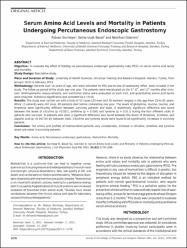| dc.contributor.author | Sivritepe, Rıdvan | |
| dc.contributor.author | Uçak Basat, Sema | |
| dc.contributor.author | Gökmen, Neslihan | |
| dc.date.accessioned | 2021-11-03T07:40:56Z | |
| dc.date.available | 2021-11-03T07:40:56Z | |
| dc.date.issued | 2021 | en_US |
| dc.identifier.citation | Sivritepe, R., Uçak Basat, S. ve Gökmen, N. (2021). Serum amino acid levels and mortality in patients undergoing percutaneous endoscopic gastrostomy. Journal of College of Physicians and Surgeons Pakistan, 31(11), 1278-1284. https://dx.doi.org/10.29271/jcpsp.2021.11.1278 | en_US |
| dc.identifier.issn | 1022-386X | |
| dc.identifier.issn | 1681-7168 | |
| dc.identifier.uri | https://dx.doi.org/10.29271/jcpsp.2021.11.1278 | |
| dc.identifier.uri | https://hdl.handle.net/20.500.12511/8550 | |
| dc.description.abstract | Objective: To evaluate the effect of feeding via percutaneous endoscopic gastrostomy tube (PEG) on serum amino acid levels and mortality. Study design: Descriptive study. Place and duration of study: University of Health Sciences, Umraniye Training and Research Hospital, Istanbul, Turkey, from January 2016 to February 2019. Methodology: Patients over 18 years of age, who were indicated for PEG due to loss of swallowing reflex, were included in the study. The follow-up period of the study was one year. The patients were reevaluated on the 3rd, 6th, and 12th months after inclusion. Anthropometric measurements, and nutritional status were evaluated at each visit, and quantitative amino acid levels were analysed. Statistical significance was accepted as p <0.05. Results: The study was carried out with a total of 53 cases (23 men and 30 women) ranging in the age from 18 to 91 years. While 13 patients were still alive, 40 patients died before completing one year. The levels of glutamine, leucine, taurine, and threonine were significantly different between surviving patients and dead. A statistically significant difference was found between the levels of citrulline (p <0.001), ornithine (p = 0.036) and tyrosine (p = 0.011) during the four different visits of patients who survived. In patients who died, a significant difference was found between the levels of threonine, ornithine, and aspartic acid (p <0.043 for all) between visits. Citrulline and tyrosine levels were found to be significantly increased in surviving patients. Conclusion: The amino acid profiles of malnourished patients vary considerably. Increase in citrulline, ornithine and tyrosine levels are noted in surviving patients. | en_US |
| dc.language.iso | eng | en_US |
| dc.publisher | Karachi : College of Physicians and Surgeons Pakistan | en_US |
| dc.rights | info:eu-repo/semantics/openAccess | en_US |
| dc.subject | Amino Acid | en_US |
| dc.subject | Percutaneous Endoscopic Gastrostomy | en_US |
| dc.subject | Malnutrition | en_US |
| dc.subject | Mortality | en_US |
| dc.title | Serum amino acid levels and mortality in patients undergoing percutaneous endoscopic gastrostomy | en_US |
| dc.type | article | en_US |
| dc.relation.ispartof | Journal of College of Physicians and Surgeons Pakistan | en_US |
| dc.department | İstanbul Medipol Üniversitesi, Tıp Fakültesi, Dahili Tıp Bilimleri Bölümü, İç Hastalıkları Ana Bilim Dalı | en_US |
| dc.authorid | 0000-0003-0547-1883 | en_US |
| dc.identifier.volume | 31 | en_US |
| dc.identifier.issue | 11 | en_US |
| dc.identifier.startpage | 1278 | en_US |
| dc.identifier.endpage | 1284 | en_US |
| dc.relation.publicationcategory | Makale - Uluslararası Hakemli Dergi - Kurum Öğretim Elemanı | en_US |
| dc.identifier.doi | 10.29271/jcpsp.2021.11.1278 | en_US |
| dc.identifier.wosquality | Q4 | en_US |
| dc.identifier.scopusquality | Q4 | en_US |


















